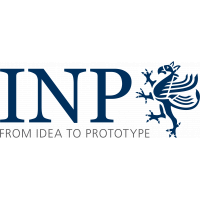The data set comprises the spatial distributions of H and O atoms in the cold atmospheric pressure plasma jet kINPen-sci. The data was obtained by means of picosecond two-photon absorption laser induced fluorescence spectroscopy (ps-TALIF) and numerical simulations.
| Field | Value |
|---|---|
| Group | |
| Authors | |
| Release Date | 2020-10-23 |
| Identifier | 74dc9377-0e4b-4595-b59b-428e841971aa |
| Permanent Identifier (DOI) | |
| Permanent Identifier (URI) | |
| Is supplementing | |
| Plasma Source Name | |
| Plasma Source Application | |
| Plasma Source Specification | |
| Plasma Source Properties | Needle to ring electrode configuration in dielectric capillary (diameter: 1.6 mm); Frequency: ~ 1 MHz; Power: 1 - 3 W |
| Plasma Source Procedure | The kINPen-sci was operated with a gas curtain that provides a concentric gas flow, which shields the plasma effluent from the influx of surrounding ambient air. The plasma jet was placed on a motorised xyz translation stage. The z-axis is defined as the axis along the symmetry axis of the effluent through the centre of the plasma jet nozzle, the x-axis is the axis parallel to the laser beam, which crosses the centre of the nozzle. |
| Plasma Medium Name | |
| Plasma Medium Properties | Feed gas: 3 slm Ar with 3000 ppm humidity; Gas curtain: 5 slm N2/O2 mixture, composition of the gas curtain can be varied from pure nitrogen to pure oxygen |
| Plasma Diagnostics Name | |
| Plasma Diagnostics Properties | The picosecond laser system was based on an Nd:YAG pump laser (1064 nm) with a mode-locked oscillator, a regenerative amplifier, and a single pulse power amplifier, producing a weak pulse train output and a strong single pulse output with a single pulse duration of 30 ps with a repetition rate of 10 Hz. In a second laser unit the weak train beam is amplified and frequency-tripled (355 nm), the strong single pulse beam is frequency-tripled only, while the left-over of the 1064 nm single pulse is the third output beam. In the third laser unit the 355 nm train enters an optical parametric oscillator (OPO) state providing tunable but weak radiation between 420 to 710 nm, that is amplified using the strong 355 nm single pulse in a subsequent optical parametric amplifier (OPA) stage. Subsequent frequency-doubling is used to generate the UV wavelengths between 210 to 355 nm, and additional sum-frequency mixing with the left-over 1064 nm single pulse input for the deep UV wavelengths below 210 nm. In the UV range, 30 ps laser pulses were generated, with a pulse energy of a few hundred µJ at the maximum, and a spectral width of approximately 4 cm−1. The standard deviation of the shot-to-shot fluctuations in the pulse energy is approximately 8%. |
| Plasma Diagnostics Procedure | Experiment: Model: |
| Language | English |
| License | |
| Public Access Level | Public |
| Contact Name | Klose, Sarah-Johanna |
| Contact Email |
Data and Resources
- Spatial distribution of hydrogen and oxygen atoms in a cold atmospheric pressure plasma jet - Fig. 3 (experimental data)csv
Total TALIF signal of the O 2p^3_4 3P_J=2 -> 3p^3P_J=1,2,0 transition as...
Preview Download - Spatial distribution of hydrogen and oxygen atoms in a cold atmospheric pressure plasma jet - Fig. 3 (Gaussian fit)csv
Gaussian fit of the total TALIF signal of the O 2p^3_4 3P_J=2 -> 3p^3P_J=...
Preview Download - Spatial distribution of hydrogen and oxygen atoms in a cold atmospheric pressure plasma jet - Fig. 4 (experimental data)csv
Time resolved O(3p^3P_J) TALIF signal at z = 0.25 mm obtained with 0.5 ns...
Preview Download - Spatial distribution of hydrogen and oxygen atoms in a cold atmospheric pressure plasma jet - Fig. 4 (exponential fit)csv
Exponential fit of the decay of the time resolved O(3p^3P_J) TALIF signal at...
Preview Download - Spatial distribution of hydrogen and oxygen atoms in a cold atmospheric pressure plasma jet - Fig. 5csv
Density of O and H as a function of x at z = 0.25 mm, z = 2.30 mm, and z = 3...
Preview Download - Spatial distribution of hydrogen and oxygen atoms in a cold atmospheric pressure plasma jet - Fig. 6csv
Measured O atom density at z = 1 mm with dry argon feed gas as a function of...
Preview Download - Spatial distribution of hydrogen and oxygen atoms in a cold atmospheric pressure plasma jet - Fig. 7acsv
Spatial density distributions of O atoms as a function of the radial...
Preview Download - Spatial distribution of hydrogen and oxygen atoms in a cold atmospheric pressure plasma jet - Fig. 7bcsv
Spatial density distributions of O atoms as a function of the radial...
Preview Download - Spatial distribution of hydrogen and oxygen atoms in a cold atmospheric pressure plasma jet - Fig. 7ccsv
Spatial density distributions of H atoms as a function of the radial...
Preview Download - Spatial distribution of hydrogen and oxygen atoms in a cold atmospheric pressure plasma jet - Fig. 7dcsv
Spatial density distributions of H atoms as a function of the radial...
Preview Download - Spatial distribution of hydrogen and oxygen atoms in a cold atmospheric pressure plasma jet - Fig. 8 (experiment)csv
Measured axial density of O and H atoms as a function of the axial distance...
Preview Download - Spatial distribution of hydrogen and oxygen atoms in a cold atmospheric pressure plasma jet - Fig. 8 (simulation)csv
Simulated axial density of O and H atoms as a function of the axial distance...
Preview Download - Spatial distribution of hydrogen and oxygen atoms in a cold atmospheric pressure plasma jet - Fig. 9acsv
Production and consumption rates for O atoms as a function of the axial...
Preview Download - Spatial distribution of hydrogen and oxygen atoms in a cold atmospheric pressure plasma jet - Fig. 9bcsv
Production and consumption rates for H atoms as a function of the axial...
Preview Download

![[Open Data]](https://assets.okfn.org/images/ok_buttons/od_80x15_blue.png)